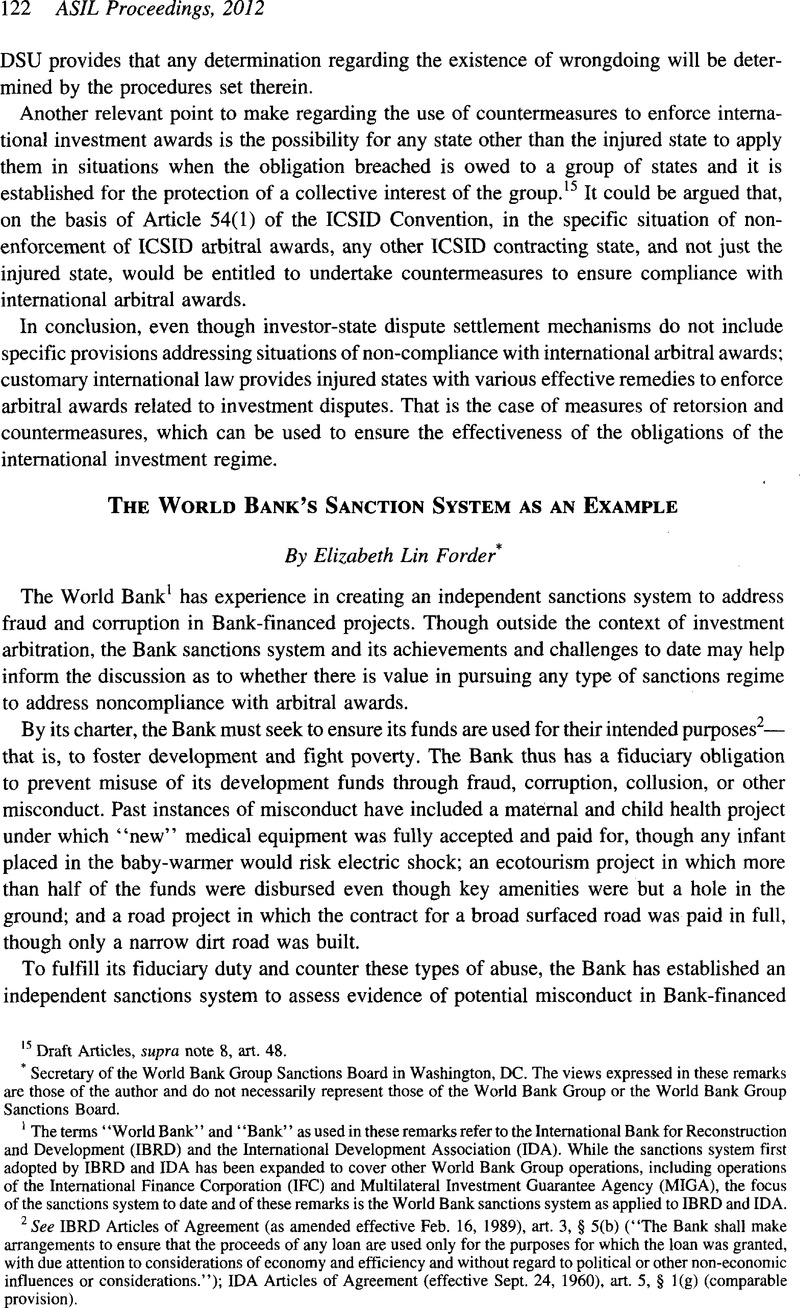No CrossRef data available.
Article contents
The World Bank’s Sanction System as an Example
Published online by Cambridge University Press: 28 February 2017
Abstract

- Type
- Sanctions in International Investment Law
- Information
- Copyright
- Copyright © American Society of International Law 2012
References
1 The terms “World Bank” and “Bank” as used in these remarks refer to the International Bank for Reconstruction and Development (IBRD) and the International Development Association (IDA). While the sanctions system first adopted by IBRD and IDA has been expanded to cover other World Bank Group operations, including operations of the International Finance Corporation (IFC) and Multilateral Investment Guarantee Agency (MIGA), The focus of the sanctions system to date and of these remarks is the World Bank sanctions system as applied to IBRD and IDA.
2 See IBRD Articles of Agreement (as amended effective Feb. 16, 1989), art. 3, § 5(b) (“The Bank shall make arrangements to ensure that the proceeds of any loan are used only for the purposes for which the loan was granted, with due attention to considerations of economy and efficiency and without regard to political or other non-economic influences or considerations.”); IDA Articles of Agreement (effective Sept. 24, 1960), art. 5, § 1(g) (comparable provision).
3 See World Bank Sanctions Procedures (as amended through July 8, 2011), § 1.02(a) (“Sanctionable Practice”), at http://www.worldbank.org/sanctions [hereinafter Sanctions Procedures].
4 World Bank Group Sanctions Board Law Digest 22 (Dec. 2011), available at http://go.worldbank.org/S9PFFMD6X0 [hereinafter Digest].
5 Sanctions Procedures, supra note 3, at § 9.01 (“Range of Possible Sanctions”).
6 Id., § 9.01(c).
7 Id.
8 Digest, supra note 4, at 69-78. See www.worldbank.org/debarr for a current list of debarred parties and their applicable debarment periods.
9 Sanctions Procedures, supra note 3, § 9.01(b) (conditional non-debarment); § 9.01(d) (debarment with conditional release).
10 Id.
11 World Bank Sanctioning Guidelines, at 1, available at http://siteresources.worldbank.org/EXTOFFEVASUS/Resources/WorldBankSanctioningGuidelines.pdf [hereinafter Sanctioning Guidelines].
12 Digest, supra note 4, at 17.
13 Id.
14 Sanctions Procedures, supra note 3, art. 4.
15 Id., § 5.01 (defining grounds for appeal); § 8.03 (noting finality of Sanctions Board decisions).
16 World Bank Group Sanctions Board, Statute, art. 5 (rev. Sept. 15, 2010), aihttp://siteresources.worldbank.org/EXTOFFEVASUS/Resources/SanctionsBoardStatute_9_15_2010.pdf.
17 Sanctions Procedures, supra note 3, § 7.01.
18 Id., § 13.02 (stating the Bank “may amend, supplement, or otherwise revise these Procedures at any time, with or without notice”).
19 As provided in the Bank’s charter, The Executive Directors are responsible “for the conduct of the general operations of the Bank,” while the Bank’s President “shall conduct, under the direction of the Executive Directors, The ordinary business of the Bank.” IBRD Articles of Agreement, art. 5, §§ 4(a), 5(b).
20 See http://www.crossdebarment.org for the text of the “Agreement for Mutual Enforcement of Debarment Decisions” signed on April 9, 2010, by the African Development Bank Group, Asian Development Bank, European Bank for Reconstruction and Development, Inter-American Development Bank Group, and World Bank Group; and Article Xii of the World Bank Sanctions Procedures for implementing provisions within the Bank’s framework.
21 See generally Digest, supra note 4.
22 Sanctions Procedures, supra note 3, § 10.01(b).
23 Id., art. 11.
24 Agreement for Mutual Enforcement of Debarment Decisions, supra note 20, para. 2 (identifying core principles that must be incorporated into each participating institution’s internal sanctioning mechanisms).


